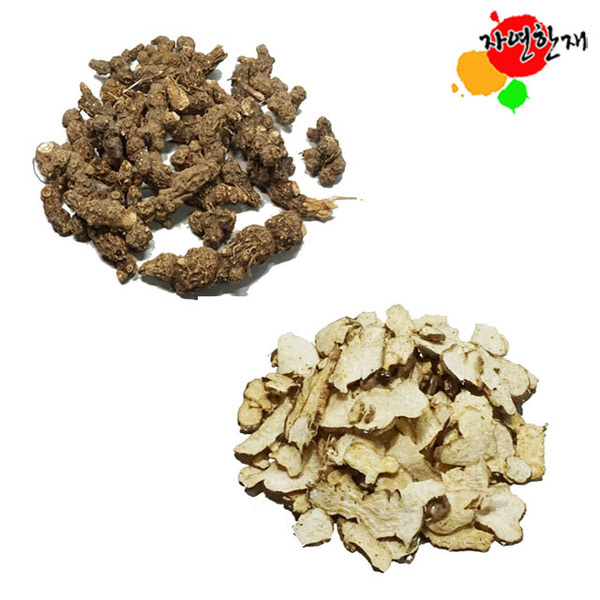Cang Zhu and Bai Zhu, two prominent herbs in traditional East Asian medicine, have long been used for their various therapeutic properties. These two herbs are considered to belong to different categories in Traditional Chinese Medicine (TCM).
Cang Zhu is classified as a 'releasing dampness herb,' while Bai Zhu is categorized as a 'tonifying qi herb.' Cang Zhu, 蒼朮, Atractylodis Rhizoma, is an herb with a warm, acrid, and bitter taste. It is associated with the Spleen and Stomach channels and is typically used in doses of 3-9g. Cang Zhu's actions include strongly drying dampness and strengthening the Spleen, as well as inducing perspiration and dispelling wind-dampness. However, it is important to note that it is contraindicated for individuals with heat from yin deficiency or spontaneous perspiration from exterior deficiency.
On the other hand, Bai Zhu, 白朮, Atractylodis macrocephalae Rhizoma, is an herb with a warm, bitter, and sweet taste. It is also associated with the Spleen and Stomach channels and is used in doses of 6-15g. Bai Zhu's actions include tonifying the Spleen and augmenting the qi, drying dampness and regulating water, stabilizing the exterior and stopping perspiration, and calming the fetus. It is contraindicated for individuals with internal heat from yin deficiency or thirst from exhausted fluids. Overdose of Bai Zhu may cause vomiting of blood, bloody stools, and agitation. | ||||
| Figure: Cang Zhu (top) and Bai Zhu (bottom) |
However, the distinction between these two herbs has not always been clear, and the classification of their source plants has evolved over time. In this essay, we will examine the historical context of Cang Zhu and Bai Zhu, explore their modern classification in different pharmacopoeias, and discuss the implications of this differentiation for contemporary herbal medicine.
Historical Context
Originally, Cang Zhu and Bai Zhu were not regarded as distinct herbs. In the ancient Chinese medical text, Shennong Bencao Jing(神農本草經, 100AD), they are both listed as Zhu (朮) without differentiation. The distinction between the two emerged in the Bencao Jing Jizhu(本草經集注) by Tao Hongjing 陶弘景 (456–536AD) where they are differentiated into Bai (白) and Chi (赤) based on appearance and form, but their effects remained undifferentiated. It was not until the Song Dynasty that Kòu Zōng Xiè (寇宗奭) in Bencao Yan Yi (本草衍义, 1116AD) separated the effects of Cang Zhu and Bai Zhu, establishing them as distinct herbs with different therapeutic properties.
Modern Classification
Today, Cang Zhu and Bai Zhu are recognized as distinct herbs derived from different plants. In the Korean Pharmacopoeia, Cang Zhu is defined as Atractylodis lancea (모창출) and Atractylodis chinensis (북창출), while Bai Zhu is defined as Atractylodes japonica (삽주) and Atractylodes macrocephala (당백출). In the Chinese Pharmacopoeia and the Taiwanese Pharmacopoeia, only the root stem of A. macrocephala is described as Bai Zhu. In the North Korean Pharmacopoeia, only A. koreana is described as Cang Zhu.
However, the classification of Cang Zhu and Bai Zhu in Korea is generally based on whether the outer skin of the root is removed or not. The dried roots of A. japonica, with the hairy roots removed, are called Cang Zhu, while the dried roots with the skin removed are called Bai Zhu. The Korean medical text Donguibogam also describes Bai Zhu as Atractylodes japonica and lists Cang Zhu as an additional item under Bai Zhu.
Implications for Contemporary Herbal Medicine
The differentiation of herbs plays a crucial role in the practice of herbal medicine. The distinction between Cang Zhu and Bai Zhu varies among major countries that utilize Traditional Chinese Medicine (TCM), with the United States predominantly following the Chinese system. Gaining a comprehensive understanding of the unique therapeutic properties of each herb, as well as the source plants from which they are derived, allows for more accurate and effective treatments. Consequently, thorough research into historical literature and modern validation is essential.
The author raises doubts about whether Cang Zhu and Bai Zhu are genuinely distinct herbs classified into separate categories. The author personally believes that Cang Zhu is essentially Zhu (Bai Zhu) with marginally enhanced diuretic properties. According to the author's perspective, the commonalities between these two herbs surpass their differences.